Software is a computer program that instructs a computer on what to do and how to do it. In other words, the software is a set of instructions fed to a computer to accomplish a specific task. The process used to design, develop, and deploy software is called software development. It involves a series of steps, called phases, to create computer programs or software.
Well, this article intends to make you familiar with software development, its history, and the key steps involved in software development. Also, we shall introduce you to the types of software, various software development tools, and jobs in software development.
So without further ado, let’s get started.
What is Software Development?
Software development is the process of building a software or computer program to address a specific business goal or accomplish a particular task. In other words, we can define software development as the process of designing, programming, documenting, testing, and debugging applications, frameworks, or software components.
In a nutshell, software development is the process that starts from developing an idea or plan of the software product to the final manifestation of the software and maintaining it after the deployment.
There are different phases involved in software development, right from specifying the requirements and writing code to ensuring that the requirements are met, and software is made live in the market.
The development process does not end after releasing the software product to end-users. Instead, it continues where developers release updates and maintain the software product regularly so that it can adapt to changes. This is referred to as the software development life cycle (SDLC).
More precisely, the software development life cycle (SDLC) includes various phases for the development of software products that meet user requirements and technical specifications.
History
Tom Kilburn, a computer scientist, is the man who wrote the world’s first piece of software. It was executed or run in 1948 at the University of Manchester in England. He had built one of the first computers, the Manchester Small-Scale Experimental Machine (SEEM).
The Manchester Small-Scale Experimental Machine performed mathematical calculations using machine code instructions. This software took 52 minutes to calculate the great divisor of 2 to the power of 18.
After this breakthrough invention, a decade later, computers were programmed with punch holes, where each hole represented the specific machine code instructions. Later, one of the very first programming languages, Fortran, was introduced in 1957.
In 1958, John Tukey coined the term ‘software’ in his article about computer programming. Later, in the next two decades, a plethora of programming languages, including Pascal, Basic, COBOL, and C, were developed.
The Personal Computing Era
In the 1970s, the introduction of personal computers has increased the demand for software.
Apple, an American multinational technology company, developed a revolutionary product, Apple II, in 1977. VisiCalc is the first spreadsheet software for personal computing that appeared in 1979 and was the Apple II’s killing app.
Thereafter, many companies entered the software market. IBM (International Business Machines) Corporation, an American multinational technology company, launched IBM PC in 1981. Therefore, with an increase in the development of personal computers, the development of software increased.
The mid of 1980s witnessed the development of various software, such as Microsoft Excel, AutoCAD, Microsoft Word, etc.
Open-source Software
Open-source software is another major breakthrough in the field of software development. The first open-source software was Linux Kernel. It is an operating system, whose first release was in 1991.
Mobile Devices
The year 1973 witnessed the world’s first mobile phone call. Later, in 1993, IBM released the first smartphone publicly, and in 1996, they introduced Palm OS. The coming years witnessed the development of a myriad of mobile devices, and the mobile development industry boomed at a faster pace than ever before. This, in turn, resulted in the immense need for software development.
Software Development Today
Software is the heart and soul of today’s digital era. It has become ubiquitous in every sector. As time passed, various programming languages were developed, which made the development of software easier than before.
The software development industry has come a long way, and today, it is one of the fastest-growing industries across the globe.
Types of Software
Basically, there are two different types of software, namely system software, and application software. Let us discuss each of these types in detail below.
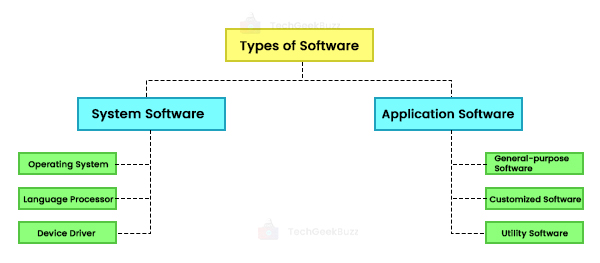
1. System Software
System software is the software responsible for operating the computer hardware. It provides the basic functionalities to the users and other software installed in a computer system. In other terms, system software is software that controls a computer system’s internal functioning and hardware, such as storage devices, monitors, printers, etc.
Moreover, system software acts as an interface between hardware and user applications. It helps them communicate with each other because hardware understands machine language, while user applications operate in human-readable languages.
There are three different types of system software, namely operating system, language processor, and device driver.
- Operating System: An operating system is system software that manages software resources and computer hardware and offers common services to computer programs. It is the first software that loads when you turn on your computer. It acts as an interface between the users and the computer system. Some common examples of operating systems are Windows, macOS, and Linux.
- Language Processor: A language processor is system software that converts human-readable language into machine language and vice-versa. It is responsible for converting programs written in high-level languages, such as C, C++, or Java, into machine language. Compilers, assemblers, and interpreters are popular language processors.
- Device Driver: A device driver is system software that controls and helps a specific device to perform certain functions. Devices such as a printer, mouse, or modem require a driver to connect to the computer system.
2. Application Software
Application software is a software intended to perform a specific task or function. The primary objective of application software is to help users accomplish a variety of tasks. Therefore, the application software is developed with the sole purpose of fulfilling the end user's requirements. Some popular examples of application software are Microsoft Word, Microsoft Excel, VLC Media Player, Spreadsheets, Google Chrome, etc.
There are three types of application software, namely general-purpose software, customized software, and utility software.
- General-purpose Software: As its name suggests, general-purpose software serves a variety of purposes and is not limited to a single task. Examples of general-purpose software include MS Word, MS Excel, Powerpoint, etc.
- Customized Software: The customized software is designed to perform specific tasks or functions for a specific organization. Examples of customized software include railway reservation systems, airline reservation systems, etc.
- Utility Software: The utility software supports the infrastructure of a computer system. They analyze, configure, optimize, and maintain your computer system. Examples include disk fragmenter, disk repairer, disk space analyzer, memory tester, etc.
Key Steps Involved in Software Development
We have discussed that software development is a series of steps followed to develop high-quality software products. Let us discuss the steps in the software development process below.
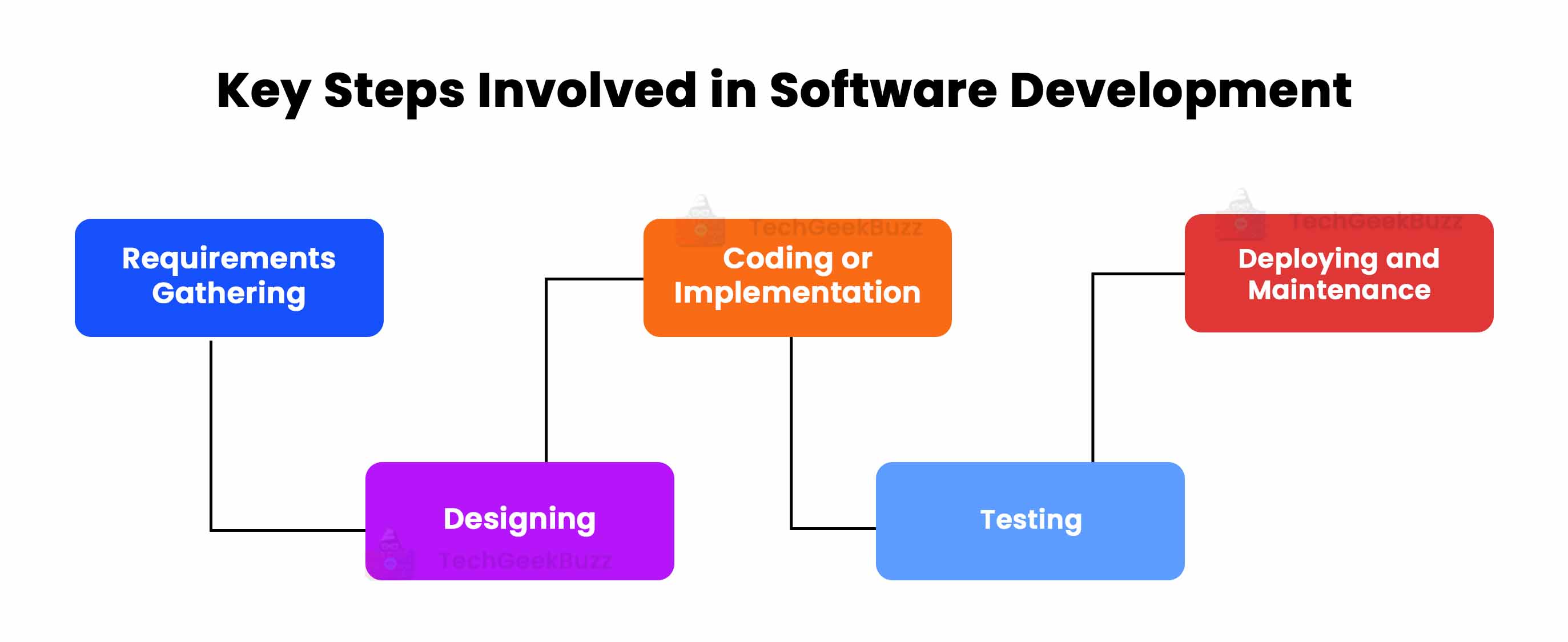
- Requirements Gathering: The first step is to collect the requirements from stakeholders or customers. These requirements specify what they expect from the software product.
- Designing: Once the requirements are defined, the next step is to design the architecture of the software product.
- Coding or Implementation: This is an integral part of software development. In this step, programmers write the code for the software product.
- Testing: After programmers write code, testers need to check the software and identify the bugs or errors present within the software. If there are any errors or bugs, testers have to send back the code to programmers to fix the errors. Once programmers fix the code, they again send it to testers for retesting. This process continues until the code has no errors or bugs.
- Deploying and Maintenance: Once code is free from bugs and defects, it is deployed and made live to end-users. After the release of the software product, end-users may face minor issues. In such cases, you need to update the software product and maintain it to adapt to new changes.
Software Development Tools
A software development tool is itself a computer program or software specially designed to help developers create robust software applications. It is a computer program that assists developers in creating, debugging, and maintaining software applications.
The basic software development tools include a source code editor and a compiler or interpreter. Various other development tools include GUI designers, assemblers, integrated development environments (IDEs), linkers, disassemblers, load testers, debuggers, etc.
- Source Code Editor: It is a text editor that helps developers write the source code of computer programs.
- Compiler: A compiler is a computer program or system software that converts source code written in one programming language into another. In other terms, it is system software that translates source code from a high-level language to a low-level language.
- Interpreter: An interpreter is a computer program that directly executes the source code without converting it into a machine or low-level language. It executes the program code line-by-line and stops the execution upon encountering an error.
- Debugger: A debugger is a software specially designed to test and debug program codes.
- Integrated Development Environment (IDE): An IDE is a single application that combines multiple developer tools under a single GUI. In general, an IDE at least consists of a source code editor, a compiler or interpreter, and a debugger.
- Assembler: An assembler is a computer program that converts computer programs written in assembly language into a pattern of bits that a computer’s processor can understand.
- Linker: It is a computer program that takes multiple object files and combines them into a single executable file.
To know some popular and widely used software development tools, you can refer here .
Jobs in Software Development
Since the software development industry is booming and evolving rapidly, it opens up a lot of career opportunities. Today, the demand for skilled programmers and developers is quite high.
If you wish to build your career in software development, there are a wide variety of options available. Some common job roles in the software development industry are listed below:
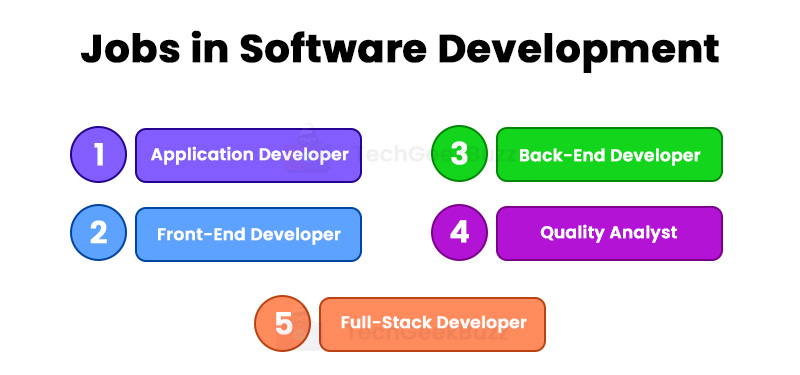
1. Application Developer
Application Developers, also known as Software Architects, are responsible for creating, modifying, testing, and debugging the source code of an application. Their job responsibilities include writing top-notch code that complies with an organization’s guidelines and standards. Also, they are responsible for modifying existing codes as and when required.
To become an application developer, you must master at least one in-demand programming language.
2. Front-End Developer
Front-End Developers are professionals who specialize in designing website interfaces. They are responsible for building client-side web applications and websites using HTML, CSS, and JavaScript. In addition, they are responsible for designing a website’s layout.
To become a front-end developer, you need to master CSS, HTML, and JavaScript. Moreover, you need to have a solid knowledge of various front-end frameworks .
3. Back-End Developer
Back-End Developers are professionals who create computational logic for websites and web applications. In other terms, they are responsible for the server-side development of applications. The responsibilities of back-end developers include writing clean code for building an application or website, performing UI testing, troubleshooting, and building reusable libraries and codes.
To build your career as a back-end developer, you need to master any one of the popular high-level programming languages.
4. Quality Analyst
Quality Analysts, also known as Quality Assurance Analysts or Test Engineers, are responsible for evaluating software systems, applications, and other digital products. Such evaluation ensures that a software product is free from technical errors or bugs and meets quality standards.
The primary responsibility of quality analysts is to design and execute test plans to validate software products for security, reliability, correctness, and flexibility.
To become a quality analyst, you must have a profound knowledge of software testing. You can consider pursuing a software testing course to master software testing.
5. Full-Stack Developer
Full-Stack Developer is one of the most in-demand job roles in the software development industry. A full-stack developer works progressively on the front-end and back-end of applications. Therefore, full-stack developers possess solid knowledge of both back-end and front-end technologies.
To become a full-stack developer, you need to master all three web technologies, i.e., HTML, CSS, and JavaScript. In addition, you need to have in-depth knowledge of a server-side scripting language, such as PHP, Python, Node.js, or Java, along with a database management system , such as SQLite or MongoDB.
Conclusion
As every industrial vertical uses distinct software products to accomplish a variety of tasks, software development has become a critical part of this digital era. Software development is a planned and structured process with a definite number of stages or phases to build high-quality and reliable software products.
We hope that this article has provided you with insights into the software development process and the various approaches used to develop software products. You can post your queries and suggestions regarding this article in the comments section below.
People are also reading:
![What is Software Development? [Definition, Stages, Tools]](/media/new_post_images/What_is_Software_Development.webp)

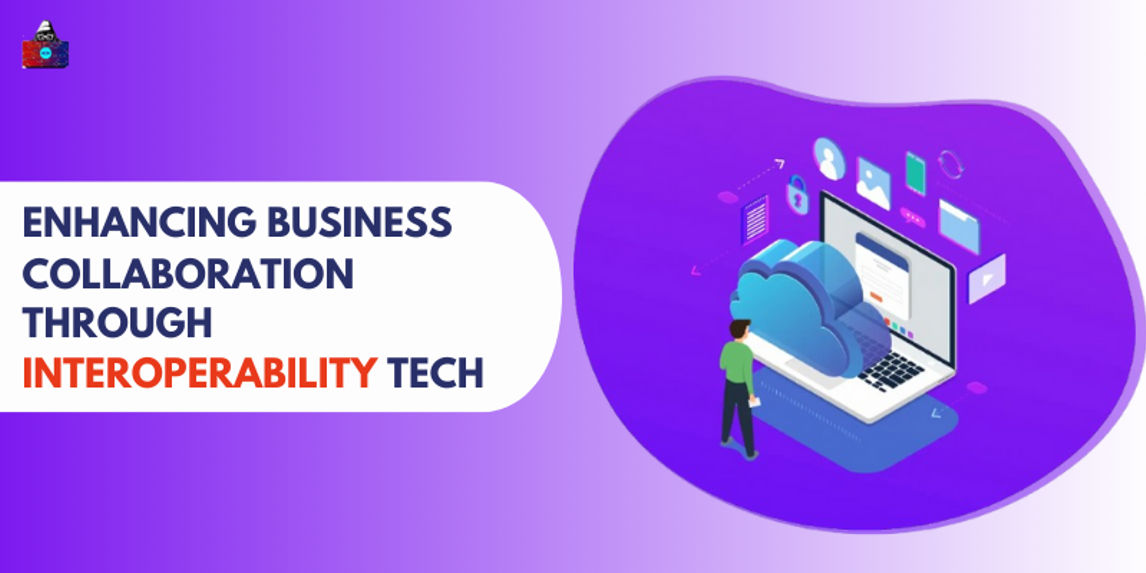
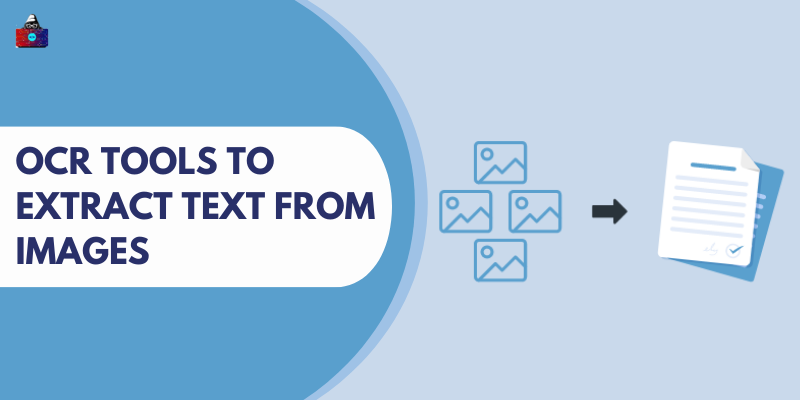
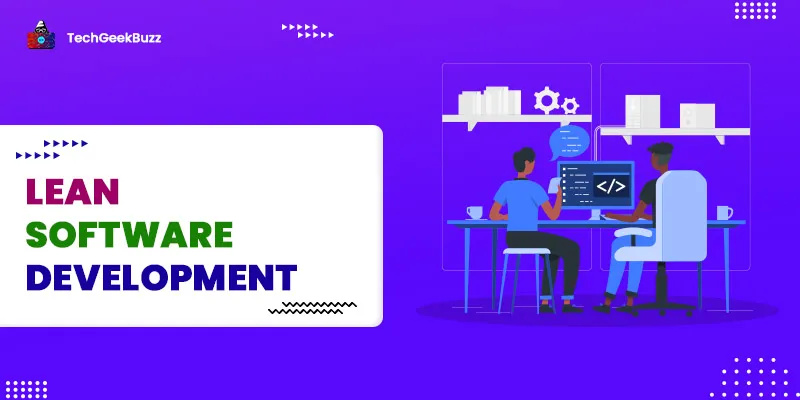
Leave a Comment on this Post